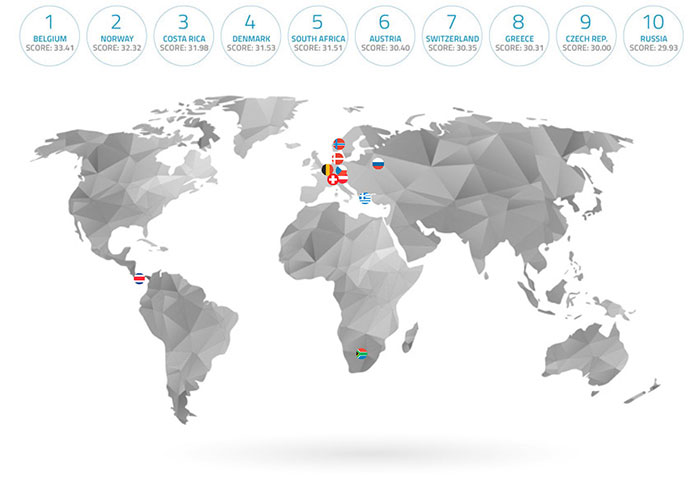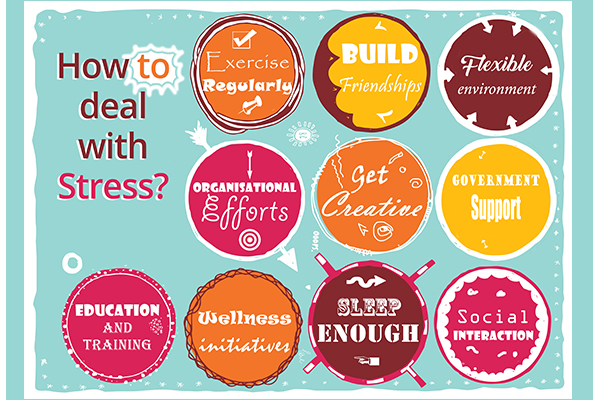Stress is not viewed negatively, till the time it exceeds comfort levels. Numerous studies show that excessive workplace stress interferes with an employee’s productivity and performance, and this trend has escalated progressively over the past few years. The primary drivers of increased level of job stress are long hours, tight deadlines, ever-increasing demands and having little control.

Source: StressPulse Survey
According to a new survey by Harvard School, nearly half (44%) of working adults are adversely affected by their current job, and only 28% are happy with their work life. Nearly one in seventeen people suffer from serious mental condition, of which 5-6% have significant health issues.
Individual efforts to combat stress at work
Social Interaction is one of the primary ways to deal with stress. It is nature’s antidote to falling prey to unwanted emotions that arise at work. Sharing thoughts and feelings with another person, developing friendships help reduce anxiety and act as a pillar to bury one’s problems and worry to an extent. Getting creative, being spiritual, cultivating gratitude, sleeping enough and exercising regularly are some simple ways to reduce stress.
Organisational efforts
In many countries, it is the legal responsibility of the employer to recognise workplace stress to prevent employees from falling sick. Since past couple of years, organisations worldwide have witnessed customer complaints, high staff turnover and increased absenteeism which have led them to devise initiatives to combat stress.
Employee assistance programs include in-house counselling programs to manage stress at work. These programs teach stress control and inoculation techniques like relaxation and cognitive restructuring. Encouraging participation, providing opportunities for social interaction, setting up support groups, instituting work-life balance techniques, offering voluntary reduced work time, installing child care initiatives, introducing stress-reducing activities, sensitivity training and most importantly evaluating success of these programs help improve productivity and lower overall costs.
Fortune 100 companies serve as an example for corporations and employers to motivate their employees to be fit and healthy. Walmart in its health care program offers its employees access to affordable medical coverage to manage health and wellbeing. Chevron’s onsite fitness centres provide a wide range of health training and education programs. Apple keeps coming out with innovative ways to fortify wellness amongst employees, latest being its new advert ‘Strength’ promoting workout features. Phillips 66, in partnership with WebMD provides services like health assessment, health record, WebMD Pregnancy Assistant. In its ‘Workout Buddies Program’, Ford Motors offers employees fitness and exercise classes. AT&T has initiated its GlowCaps program that reminds people to take their medication daily via texts, mails and calls. IBM’s online ‘Commit to Health Community’ is a forum for its employees around the world to share ideas and impart health education. Likewise, companies are introducing various innovative and environment oriented initiatives to make their workplace a healthier and pleasant workplace to work in.

Source: universumglobal.com
Denmark, Austria, Costa Rica, Belgium, Greece, Norway, Russia are reported to have the highest level of satisfaction in the workplace.
Government and External Community efforts
Around the world, governments are also acknowledging the importance of having a healthy workforce and is supporting organisations sustain employee well-being efforts. A well-adjusted/happy employee is a productive employee.
In UK, The National Institute for Clinical Excellence (NICE) has introduced guidance for employers on ‘Promoting mental wellbeing through productive and healthy working conditions’ for the employers and employees.
Corning’s holistic stress management program is an initiative resulted out of a collaborative partnership between Corning Inc. and the National Institute for Occupational Safety and Health (NIOSH) that focuses on educating employees about the basic nature, symptoms and consequences of stress.
In India, the Labour Ministry has formulated national policies to be adopted by organisations for occupational safety and health.

Source: profit.ndtv.com
This year, The Abu Dhabi Occupational Safety and Health Centre (OSHAD) on 28th April launched a Stress Management program that coincided with the International Labour Organisation’s World Day for Safety and Health at Work. It requires all the employers in Abu Dhabi to implement stress management policies in order to combat stress at work.
Australian Government has introduced a Department of Health which includes calculators to determine the impact the workplace well being initiatives are having on the workforce.
Government of South Australia in its ‘Get Healthy’ program provides free information and telephone based coaching service that helps employees and non-employees better their lifestyle in terms of healthy eating, being physically active and mentally relaxed.
In December 2015, the Japanese Ministry of Health, Labour and Welfare, in its Industrial Safety and Health Act introduced that all organisations employing 50 and more employees are required to establish a health committee offering an annual stress check-up for their employees. For this, employers can use stress check software, set of ministry questions or any form of stress assessment tests. The report is to be submitted to the labour standards office, failing which the employer may face penalties.
In the UK, the Health and Safety Executive (HSE) has issued a guide entitled ‘Tackling Stress’- The Management Standards Approach, which outlines 6 areas of workplace that need to be monitored to assess levels of stress, namely- demand, control, support, relationship, role and change.
Stress in the workplace can affect every aspect of business. As per American Institute of Stress, workplace stress costs organisations over $300 billion annually in lost productivity due to absenteeism, healthcare expenditures and increased turnover. It is vital to recognise the signs of stress at an early stage and take action before it takes a toll on the health and wellbeing of the employee and the organisation.
